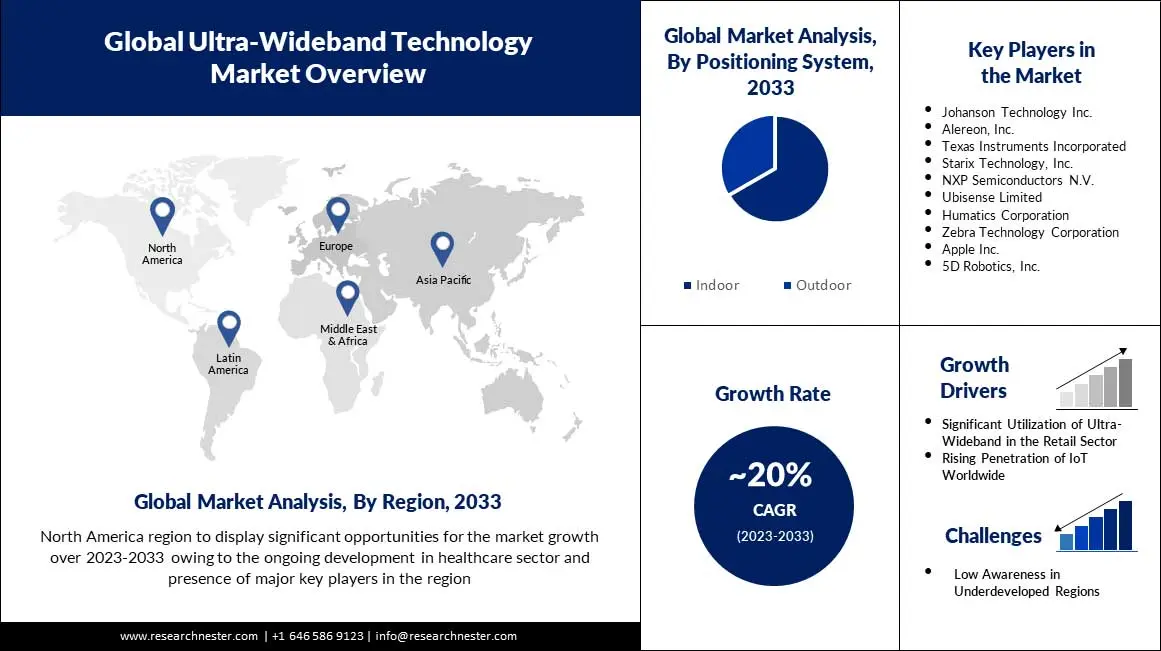
Ultra-wideband Market size is slated to cross USD 5 Billion by the end of 2033, growing at a CAGR of 20% during the forecast period, i.e., 2023-2033. In the year 2022, the industry size of ultra-wideband was over USD 1 Billion.The growth of the market can primarily be attributed to the spiking penetration of smartphones and other personal electronic devices across the globe. UWB technology is particularly precise in terms of interior navigation and position tracking, making it a useful solution for use in consumer gadgets such as smartphones. Smartphones and other portable electronic devices are rapidly being used to perform high-bandwidth applications that demand low-latency wireless connections, such as watching online video and gaming. Therefore, UWB technology is ideal for these kinds of applications, and it is anticipated to surge the market’s growth in the upcoming years. For instance, smartphone subscriptions were estimated to hit approximately 5000 million in 2018 and are projected to reach about 7000 million by the year 2027 globally.
Global ultra-wideband market trends such as significant expansion in the IT sector and the growing prevalence of wireless sensor networks are projected to influence the growth of the market positively over the forecast period. For instance, in 2022, the IT sector spent about USD 1 trillion on telecommunication across the globe, and that is expected to rise in the coming years. Moreover, up-surged mobile data traffic on the back of a rising number of internet users is further expected to fuel the market growth over the forecast period. Hence, all these factors are estimated to propel the growth of the market over the forecast period.

Growth Drivers
Challenges
|
Base Year |
2022 |
|
Forecast Year |
2023-2033 |
|
CAGR |
~20% |
|
Base Year Market Size (2022) |
~USD 1.0 Billion |
|
Forecast Year Market Size (2033) |
~USD 5.0 Billion |
|
Regional Scope |
|
Positioning System (Indoor, Outdoor)
The global ultra-wideband market is also segmented and analyzed for demand and supply by positioning systems into indoors and outdoors. Out of these segments, the indoor segment is projected to garner a higher market share by end of 2033. Since typical GPS signals may be weak or hindered in confined locations such as buildings, indoor positioning systems are more frequently employed in these settings. Since of its broad bandwidth and low power requirements, UWB is a good fit for this application, as it can deliver precise position data using time-of-flight (ToF) measurements even in settings with a lot of multipath interference. Applications for these include asset tracking, interior navigation, and emergency response, among others. For instance, as per the reported data, UWB technology is much more accurate than other wireless technologies such as Wi-Fi or Bluetooth with an accuracy of 10-35 cm.
Application (Communication, Imaging, RTLS)
The global ultra-wideband market is segmented and analyzed for demand and supply by application into communication, imaging, real time location system (RTLS), and others, out of which, the real time location system (RTLS) segment is projected to witness noteworthy growth over the forecast period. The growth of the segment can be accounted to the booming implementation of real-time location services across the globe in multiple industries. Moreover, it helps to determine the location of particular equipment, and patients in the healthcare sector, and it is expected to boost the segment’s growth over the forecast period. For instance, in 2022, the implementation of Bluetooth real-time location services in various verticals such as public venues, smart offices, hospitality, healthcare, manufacturing, and others is projected to be around 58% in the world.
Our in-depth analysis of the global market includes the following segments:
|
By Positioning System |
|
|
By Application |
|
|
By End-User |
|
The North America ultra-wideband market, amongst the market in all the other regions, is projected to hold the largest market share by the end of 2033. The growth of the market can be accounted to the ongoing development of the healthcare sector and the presence of major key players in the region. In the healthcare sector, patients travel from one room to another room, and ultra-wideband is used to track the location of patients, which in turn is further anticipated to boost the market’s growth in the region. Furthermore, there has been a rising need for data communication, followed by an increasing digital population, and it is predicted to drive the growth of the market in the North America region. The data stated, more than 90 percent of the population in the United States is digitally connected. Hence, all these factors are estimated to propel the growth of the market during the forecast period.



Texas Instruments Incorporated to expand its connectivity portfolio by launching a new line of Bluetooth LE wireless MCUs. The system is developed to provide high-quality Bluetooth Low Energy at a reduced price compared to the alternative devices.
Ubisense Limited to unveil its new UB-Tag that comes with Simultaneous Ultra-Wideband and the capabilities of BLE tracking. UB-Tag is robust, small, and usable for industrial applications. The device can transmit BLE and ultra-wideband signals at the same time simultaneously.
Author Credits: Abhishek Verma, Hetal Singh
Copyright © 2024 Research Nester. All Rights Reserved

FREE Sample Copy includes market overview, growth trends, statistical charts & tables, forecast estimates, and much more.
Have questions before ordering this report?